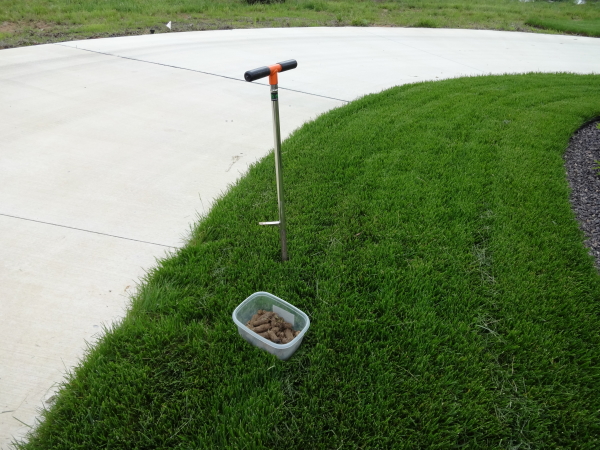Soil Analysis
A soil analysis determines the soil’s pH level, available nutrients, and organic matter percentage—key elements that must stay balanced to promote healthy turf and prevent weed growth. It also plays a vital role in diagnosing turf issues such as poor color, low seed germination, bare spots, and persistent disease problems.
The pH scale ranges from 0 to 14, with 7.0 representing neutral. Values below 7.0 indicate acidic soil, while values above suggest alkaline conditions. For ideal turf growth, aim for a slightly acidic pH between 6.5 and 6.8. To adjust the pH, conduct a soil test to determine how much limestone or sulfur to apply. Adding compost can also help shift the pH and is especially useful when the soil is highly buffered or when organic matter falls below 4%.

Turf grasses in our area need a balanced mix of 16 essential nutrients to grow at their best. When soil suffers from pH imbalances, nutrient deficiencies, or low organic matter, turf health declines—and weed problems typically follow. We partner with a local independent testing laboratory to analyze your soil and provide you with a detailed report, along with our tailored recommendations.
Our GatorGuarantee for all customers: If you're not satisfied with our service, we'll return to your property, free of charge. And if you're still not happy, we'll refund your last application and pay you $25 for your trouble!
Let's Get Started
There are no obligations and estimates are always FREE. To get started we will need some basic address and contact information and then we can provide you with pricing.
Additional Recommended Services
Our lawn care programs include scheduled applications of fertilizer and weed control. These treatments create a healthier, lush, and green lawn. A great-looking lawn results from consistent and proper care. Successful lawn care requires technical knowledge and turf management experience.
Turf grasses in our area benefit from annual lawn aeration. Aeration reduces thatch buildup and relieves soil compaction. This service improves the flow of air, water, and nutrients. Improved flow helps nutrients reach the root system more effectively.
Grub damage is the most common type of damage sustained in lawns throughout the United States. Customers who choose to add grub control to their scheduled services will receive it along with control of all turf feeding and subsurface feeding insects.
Soil Analysis & Amendments FAQ's
If soil conditions are good, testing your soil every 3 – 5 years is sufficient. However, if a deficiency is found it is our recommendation to test your soil once a year making recommended corrective actions every year until your soil tests good.
At TurfGator, we use an independent soil testing company and will provide you with a complete analysis report of the findings along with recommendations of corrective actions.
Yes, we always provide the test results to you.
You can actually test the soil at any time, but for consistent results if you are having issues it is best to test at the same time of the year every year until conditions improve. To avoid misleading test results we generally wait 4 – 6 weeks after a previous lawn care treatment.
It is dependent on what type of corrective actions that are needed. As for pH issues, limestone can be added at any time of the year, but sulfur can burn the lawn in the heat of the summer and is best to wait until fall or spring. Corrective actions in nutrients can be done at any time as well as adding organic matter.
Fertilizers directly affect plant growth by adding nutrients to the soil, while soil amendments indirectly affect plant growth by improving the soil's physical properties.
Soil conditions are very important and often overlooked by many. We treat thousands of lawns in the local area and the difference in appearance from one lawn to the next is generally one of three things, soil conditions, watering practices and cultural practices.
No, just because you have clay soil does not mean your soil is acidic. We have tested hundreds of lawns throughout the area and it is a 50/50 shot of the soil being acidic. If your soil is indeed alkaline and you add limestone unknowingly you will cause the conditions to get worse. Also, if you know for sure your soil is acidic you still don't know how many pounds per thousand sq-ft of limestone to apply. It is best to have a soil analysis done before attempting any corrective actions.
The pH scale is from 0 – 14 with 7.0 being neutral. Below 7.0 is considered acidic and above is considered alkaline conditions. The pH should be slightly acidic between 6.5-6.8 for ideal soil conditions. To raise or lower the pH level, a soil test is required to determine necessary amounts of additives such as limestone or sulfur.
Your lawn will look its best when it has the proper combination of nutrients, texture, organic matter and a proper pH level. Without this proper balance deficiency will show in your lawns color, inability to germinate seed and amount of potential weeds throughout your lawn. Testing your soil quickly determines deficiencies and with proper corrective actions you can have a great looking healthy lawn.
The addition of limestone or lime will raise pH; however, the amount needed is dependent on the results of the analysis and size of the lawn.
The addition of elementary sulfur will reduce a high pH level, however the overall process time may take several years depending on how high the pH level is and the buffer pH. Ammonia sulfate can speed up the process, but it is still a slow process.
No, adding any amendment on a routine basis is not a recommended practice. Prior to adding any amendment, it is our recommendation to have a soil analysis conducted to determine which amendments are required and at what rate, such as pounds per 1,000 sq-ft.
